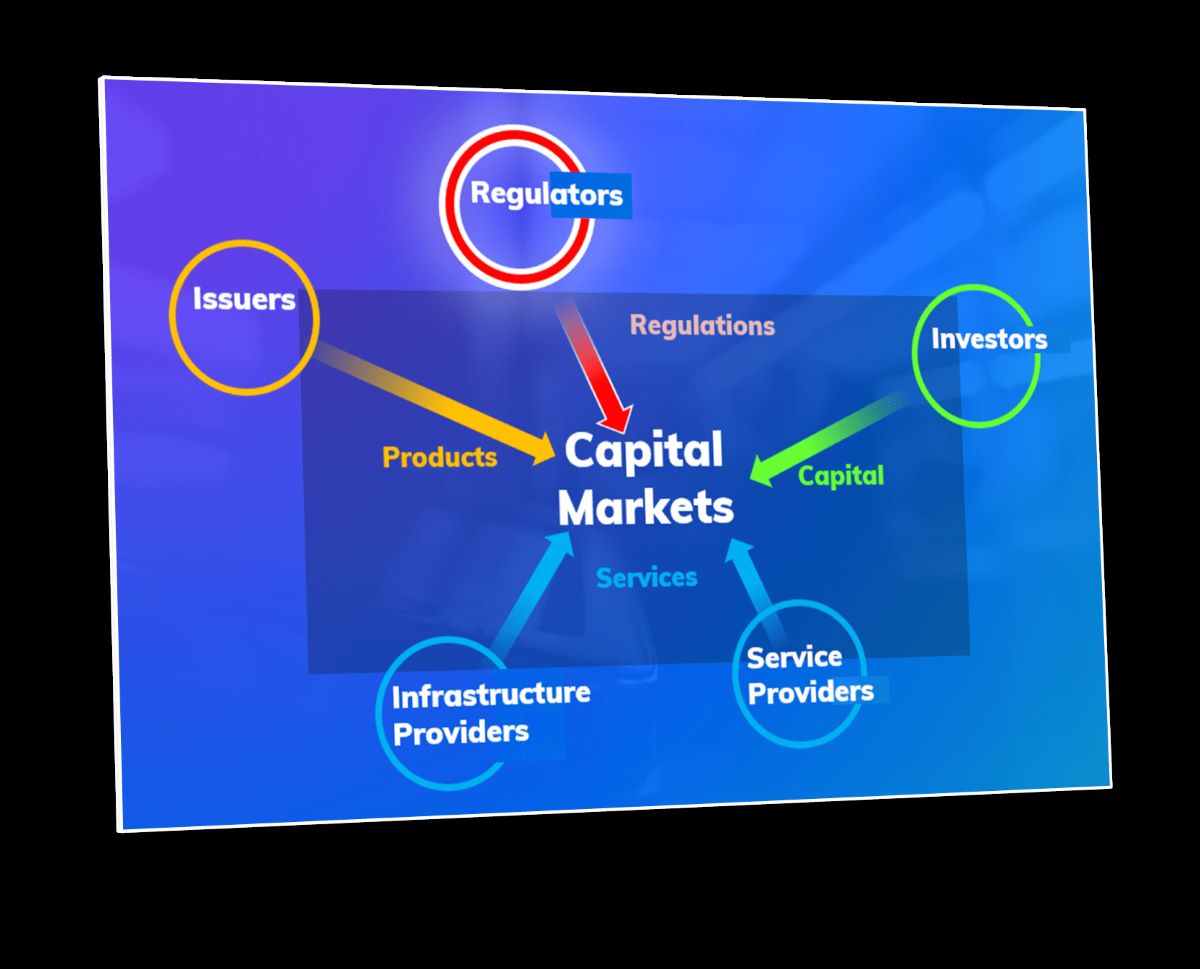

Finance
What Is A Credit Market
Published: January 13, 2024
Discover the fundamentals of the credit market and its impact on finance. Gain insights into how it works, who participates, and its significance in the world of finance.
(Many of the links in this article redirect to a specific reviewed product. Your purchase of these products through affiliate links helps to generate commission for LiveWell, at no extra cost. Learn more)
Table of Contents
Introduction
Welcome to the world of credit markets! In the complex and interconnected realm of finance, credit markets play a vital role in facilitating the flow of funds and providing access to capital for individuals, businesses, and governments. Whether you’re buying a car, securing a mortgage, or investing in bonds, credit markets are at the heart of these financial transactions.
In simple terms, a credit market can be defined as a marketplace where borrowers and lenders come together to exchange funds. It is a mechanism through which individuals and entities can borrow money or extend credit to others. Credit markets serve as a bridge between those who have surplus funds and wish to earn a return on their investment, and those who require funds to finance their various needs and initiatives.
The functioning of credit markets is essential for economic growth and development. By providing access to funds, credit markets enable individuals and businesses to make necessary investments, expand operations, and pursue new opportunities. These markets also support governments in financing public infrastructure projects, stimulating economic growth, and addressing fiscal needs.
There are various types of credit markets that cater to different needs and preferences. These include consumer credit markets, corporate credit markets, government bond markets, and international credit markets. Each of these markets has its own unique characteristics, participants, and regulations.
The key participants in credit markets include borrowers (such as individuals, businesses, and governments), lenders (such as banks, financial institutions, and investors), and intermediaries (such as credit rating agencies and credit market regulators). These players play crucial roles in ensuring efficient functioning, risk management, and enforcement of contract terms in credit transactions.
The primary function of credit markets is to allocate funds efficiently and fairly, based on factors such as creditworthiness, interest rates, and risk appetite. They provide a mechanism for determining borrowing costs and interest rates, which are influenced by various factors such as economic conditions, monetary policy, and market dynamics. Credit markets also facilitate the trading and liquidity of financial instruments like bonds, loans, and derivatives.
However, credit markets are not without risks and challenges. They can be affected by factors such as changes in economic conditions, credit quality deterioration, market volatility, and regulatory changes. Furthermore, excessive borrowing and lending can lead to systemic risks, creating financial instability and potential crises.
In the next sections, we will delve deeper into the various types of credit markets, their functions, the role of governments, and the risks and challenges they face. So, let’s explore the fascinating world of credit markets and understand their significance in driving economic growth and financial stability.
Definition of Credit Market
A credit market can be defined as a marketplace where borrowers and lenders come together to exchange funds. It is a segment of the financial market that facilitates the borrowing and lending of money.
In a credit market, individuals, businesses, or governments with a need for funds can borrow money from lenders who have surplus funds to invest. The borrowers receive the required funds, while the lenders earn a return on their investment in the form of interest.
Credit markets encompass a wide range of financial instruments and products, including loans, bonds, mortgages, credit cards, and other forms of credit. These instruments are used by borrowers to finance various needs and initiatives, such as purchasing assets, funding operations, or making investments.
One key feature of credit markets is the evaluation of creditworthiness. Lenders assess the risk profile of borrowers to determine their likelihood of repaying the borrowed funds. Factors such as credit history, income levels, collateral, and current financial obligations are considered in this evaluation process.
Based on the level of risk associated with borrowers, lenders determine the terms and conditions of the credit, including interest rates, repayment schedules, and any collateral requirements. This enables lenders to protect themselves against default risk and ensure that they are adequately compensated for taking on the risk.
Furthermore, credit markets can be categorized into different segments depending on the type of borrowers and lenders involved. These segments may include consumer credit markets, corporate credit markets, government bond markets, and international credit markets. Each segment has its own characteristics, regulations, and participants.
Consumer credit markets are focused on providing credit to individuals for personal consumption or investment purposes, often including products such as credit cards, auto loans, and mortgages. Corporate credit markets, on the other hand, cater to the borrowing needs of businesses to finance their operations, expansions, or acquisitions.
Government bond markets facilitate the issuance and trading of bonds by governments to finance their fiscal needs or infrastructure projects. International credit markets involve cross-border lending and borrowing transactions, including syndicated loans, foreign exchange markets, and international debt issuances.
In summary, a credit market is a dynamic marketplace where borrowers and lenders interact to exchange funds. It serves as a crucial mechanism for allocating capital efficiently and enabling individuals, businesses, and governments to access the funds they need to meet their financial objectives.
Importance of Credit Markets
Credit markets play a crucial role in the functioning of modern economies and financial systems. They are essential for the efficient allocation of capital, the facilitation of economic growth, and the overall stability of financial markets. Here are some key reasons why credit markets are of paramount importance:
1. Access to Capital: Credit markets provide individuals, businesses, and governments with access to the capital they need to finance various activities, such as investment, consumption, and infrastructure development. By extending credit, lenders enable borrowers to fulfill their financial needs and goals, which, in turn, stimulates economic growth and increases overall productivity.
2. Financial Intermediation: Credit markets act as intermediaries, connecting savers and borrowers. They allow individuals and organizations with surplus funds to invest and earn a return on their capital, while also providing options for borrowers to access the funds they require. This intermediation process ensures that available funds are channeled to productive uses and fosters efficient capital allocation.
3. Economic Stability: Well-functioning credit markets contribute to economic stability by facilitating consumption smoothing and risk management. They provide individuals with the ability to borrow during times of need or invest during periods of opportunity, which helps in reducing income and wealth inequalities. Moreover, credit markets allow businesses to manage cash flows and finance operational needs, ensuring business continuity and stability.
4. Investment and Innovation: Credit markets fuel investment and promote innovation. By providing the necessary funds, they enable businesses to invest in research, development, and technological advancements. This leads to the creation of new products, services, and industries, ultimately driving economic progress, job creation, and improved living standards.
5. Liquidity and Market Efficiency: Credit markets facilitate liquidity, allowing financial assets and instruments to be bought, sold, and traded. The availability of liquid markets ensures that borrowers can access funds promptly when needed and that lenders can efficiently deploy their capital. Furthermore, liquid credit markets contribute to overall market efficiency, price discovery, and transparency.
6. Risk Management and Diversification: Credit markets offer various forms of credit instruments, such as bonds and derivatives, that allow investors to manage and diversify their investment risk. By investing in different credit assets, investors can spread their risk across various borrowers, sectors, and regions, reducing the impact of potential defaults or credit events.
7. Financial Inclusion: Credit markets play a vital role in promoting financial inclusion by providing access to credit for individuals and businesses who may have been previously excluded. By offering affordable and accessible credit options, credit markets empower individuals to build assets, fund education, start businesses, and improve their overall financial well-being.
Overall, credit markets are a fundamental component of a healthy and vibrant financial system. They promote economic growth, facilitate capital allocation, support investment and innovation, and enhance financial stability. By enabling borrowers to access the funds they need and providing opportunities for investors to earn a return, credit markets contribute to the overall prosperity and development of societies.
Types of Credit Markets
Credit markets encompass a wide range of segments that cater to the specific borrowing and lending needs of individuals, businesses, and governments. Here are some of the main types of credit markets:
1. Consumer Credit Markets: Consumer credit markets focus on providing credit to individuals for personal consumption or investment purposes. These markets include various types of credit instruments, such as credit cards, personal loans, student loans, auto loans, and mortgages. Consumer credit markets enable individuals to make important purchases and investments, such as buying a home or financing education, by accessing funds that they may not have immediately available.
2. Corporate Credit Markets: Corporate credit markets cater to the borrowing needs of businesses, allowing them to finance operations, expansions, acquisitions, and other corporate activities. These markets include loans, bonds, and other credit instruments specifically designed for companies. Corporate credit markets play a critical role in providing businesses with the necessary capital to grow, invest in research and development, and navigate financial challenges.
3. Government Bond Markets: Government bond markets facilitate the issuance and trading of bonds by governments to finance their fiscal needs or infrastructure projects. These markets enable governments to raise capital by issuing bonds that are purchased by investors. Government bonds are considered relatively low-risk investments and serve as a benchmark for interest rates in the broader credit market. The government bond market is vital for ensuring governments have access to the funds necessary to fund public expenditures.
4. International Credit Markets: International credit markets involve lending and borrowing transactions that span across countries and currencies. These markets facilitate cross-border financing, including syndicated loans, international bond issuances, and foreign exchange markets. International credit markets play a crucial role in enabling global trade and investment by providing funding options for businesses and governments in different countries. They contribute to the efficient allocation of capital on a global scale.
5. Financial Markets: While not solely focused on credit, financial markets play a significant role in credit intermediation. These markets include stock markets, money markets, and capital markets. Money markets provide short-term credit to entities such as banks, corporations, and governments, while capital markets facilitate longer-term borrowing and lending through instruments like bonds and equities. Financial markets provide a platform for borrowers to access credit and for lenders to deploy their capital to earn returns.
Each type of credit market has its own characteristics, participants, and regulations. The functioning and dynamics of these markets are influenced by factors such as economic conditions, interest rates, creditworthiness, and market forces. Understanding the different types of credit markets is essential for borrowers, lenders, and investors to navigate the specific opportunities and risks associated with each market segment.
Key Participants in Credit Markets
Credit markets involve a diverse range of participants who play crucial roles in facilitating the borrowing and lending of funds. Here are the key participants in credit markets:
1. Borrowers: Borrowers are the individuals, businesses, or governments seeking funds to meet their financial needs. They borrow funds from lenders with the understanding that the borrowed amount, along with interest, will be repaid over a specified period. Borrowers may include individuals seeking personal loans, businesses looking for working capital or expansion financing, or governments issuing bonds to finance infrastructure projects or public expenditures.
2. Lenders: Lenders are entities that have surplus funds and are willing to extend credit to borrowers. They can be banks, financial institutions, credit unions, or individual investors. Lenders assess the creditworthiness of borrowers and determine the terms and conditions of the credit, such as interest rates, repayment schedules, and collateral requirements. Lenders earn a return on their investment by receiving interest payments from borrowers.
3. Intermediaries: Intermediaries play an important role in credit markets by connecting borrowers and lenders and facilitating the borrowing and lending process. They include banks, credit unions, and other financial institutions that act as intermediaries between savers and borrowers. These entities collect deposits from savers and use those funds to provide credit to borrowers, earning a margin between the interest paid by borrowers and the interest paid to savers.
4. Credit Rating Agencies: Credit rating agencies play a critical role in credit markets by assessing the creditworthiness and risk profile of borrowers. These agencies evaluate the financial health and ability of borrowers to repay their debts. They assign credit ratings, such as AAA, AA, or BBB, to borrowers based on their evaluations. These ratings provide investors and lenders with an indication of the creditworthiness and risk associated with the borrower.
5. Regulators and Government Bodies: Regulators and government bodies oversee and enforce regulations that govern credit markets. They ensure that participants adhere to ethical practices, maintain financial stability, and protect the interests of borrowers and lenders. They may set requirements for lenders’ capital adequacy, enforce regulations to prevent predatory lending, and establish rules and guidelines for the issuance and trading of credit instruments.
6. Investors: Investors participate in credit markets by purchasing credit instruments such as bonds or participating in loan syndications. They may include institutional investors, such as pension funds, insurance companies, or mutual funds, as well as individual investors looking to earn a return on their investment. Investors provide the necessary capital to lenders and borrowers, and their participation contributes to the liquidity and functioning of credit markets.
7. Market Participants: Other participants in credit markets include brokers, dealers, and traders who facilitate the buying and selling of credit instruments. They provide liquidity to the market by offering a platform for participants to trade assets and ensure market efficiency and price discovery. These participants play a crucial role in maintaining a functioning and liquid credit market.
Understanding the roles and interactions of these key participants in credit markets is essential for a smooth functioning and efficient allocation of funds. The collaboration and coordination between borrowers, lenders, intermediaries, rating agencies, regulators, investors, and market participants ensure that credit markets operate effectively, providing access to capital for those in need while managing risk and maintaining financial stability.
Functions of Credit Markets
Credit markets serve several important functions that contribute to the efficient allocation of capital and the smooth functioning of the economy. Here are the key functions of credit markets:
1. Facilitating Borrowing and Lending: One of the primary functions of credit markets is to facilitate the borrowing and lending of funds. They provide a platform for borrowers, such as individuals, businesses, and governments, to access the funds they need to meet their financial goals. Simultaneously, lenders, including banks, financial institutions, and individual investors, can deploy their surplus funds by extending credit to borrowers. Credit markets act as intermediaries, connecting borrowers and lenders and enabling the flow of funds in the economy.
2. Determining Borrowing Costs: Credit markets play a crucial role in determining borrowing costs, such as interest rates. The interest rates charged to borrowers reflect the risk associated with the credit transaction, including factors such as creditworthiness, repayment period, and market conditions. The interaction between supply and demand in credit markets helps establish the prevailing interest rates, which guide borrowing costs for individuals, businesses, and governments.
3. Providing Liquidity: Credit markets provide liquidity to financial systems by allowing borrowers to access funds promptly when needed. The availability of credit instruments, such as loans and bonds, provides borrowers with a source of immediate financing to meet their obligations or fund their activities. Additionally, credit markets also enable investors to purchase credit instruments, providing them with a liquid investment option that can be easily bought or sold based on their liquidity needs.
4. Supporting Economic Growth: Credit markets play a vital role in fostering economic growth and development. By providing access to capital, these markets enable individuals, businesses, and governments to make necessary investments, expand operations, and pursue new opportunities. Adequate access to credit promotes entrepreneurship, innovation, and job creation, driving economic progress and elevating living standards. Credit markets also support governments in financing public infrastructure projects, stimulating economic growth, and addressing fiscal needs.
5. Enabling Risk Management: Credit markets offer various financial instruments, such as bonds and derivatives, that allow investors to manage and diversify their investment risk. These instruments provide a means for investors to spread their risk across different borrowers, sectors, and regions, reducing the impact of potential defaults or credit events. Additionally, credit markets also provide borrowers with the opportunity to hedge against interest rate fluctuations through instruments like interest rate swaps.
6. Enhancing Price Discovery: Credit markets contribute to the price discovery process by establishing fair and transparent pricing for borrowing and lending. The interaction of market participants in the buying and selling of credit instruments helps establish market-driven interest rates, reflecting supply, demand, and risk considerations. Price discovery ensures that borrowers and lenders have access to fair and competitive interest rates, supporting efficient allocation of capital.
7. Promoting Financial Inclusion: Credit markets not only serve established borrowers but also promote financial inclusion by providing access to credit for individuals and businesses who may have been previously excluded. By offering affordable and accessible credit options, credit markets empower individuals to build assets, fund education, start businesses, and improve their overall financial well-being.
In summary, credit markets play vital functions in facilitating borrowing and lending, determining borrowing costs, providing liquidity, supporting economic growth, enabling risk management, enhancing price discovery, and promoting financial inclusion. By fulfilling these functions, credit markets contribute to the overall efficiency and stability of the financial system and foster economic development.
Factors Affecting Credit Markets
Credit markets are influenced by a variety of factors that impact borrowing and lending conditions. Understanding these factors is crucial for borrowers, lenders, and investors in assessing risks, determining interest rates, and navigating credit market dynamics. Here are some key factors that affect credit markets:
1. Economic Conditions: The overall economic environment has a significant impact on credit markets. Factors such as GDP growth, inflation, unemployment rates, and interest rates directly affect the demand for credit and the ability of borrowers to repay their debts. In times of economic expansion, credit markets tend to be more active and optimistic, resulting in increased lending and lower borrowing costs. Conversely, during economic downturns, credit markets may tighten, leading to reduced lending and higher borrowing costs as lenders become more risk-averse.
2. Monetary Policy: The policies and actions of central banks, such as interest rate adjustments and the implementation of quantitative easing measures, have a profound impact on credit markets. Changes in interest rates influence borrowing costs, affecting the availability and affordability of credit. Expansionary monetary policies can stimulate credit growth by lowering interest rates, while contractionary policies can restrict credit and raise interest rates to curb inflationary pressures.
3. Creditworthiness and Risk Profile: The creditworthiness and risk profile of borrowers have a direct impact on credit markets. Lenders evaluate the creditworthiness of borrowers based on factors such as credit history, income levels, collateral, and current financial obligations. Borrowers with higher credit ratings and lower perceived risk are more likely to secure credit at lower interest rates. Additionally, changes in a borrower’s creditworthiness or risk profile can affect their access to credit and the terms offered.
4. Market Sentiment and Investor Confidence: Market sentiment and investor confidence play a vital role in credit markets. Positive investor sentiment encourages lending and investment, leading to increased credit availability and lower borrowing costs. Conversely, negative market sentiment can result in risk aversion, reduced lending, and higher borrowing costs. Events such as economic downturns, geopolitical tensions, and market disruptions can influence investor confidence and impact credit market conditions.
5. Regulatory Environment: The regulatory framework governing credit markets can significantly impact their operations. Regulations imposed by government bodies and regulatory authorities aim to protect the interests of borrowers and lenders, maintain financial stability, and ensure ethical practices. Changes in regulations, such as stricter lending standards or increased capital requirements for lenders, can affect credit market dynamics by altering the availability of credit and the cost of borrowing.
6. Market Supply and Demand: The balance between supply and demand in credit markets plays a crucial role in determining borrowing costs and credit availability. When the demand for credit exceeds the available supply, borrowing costs may rise due to increased competition among borrowers. Conversely, excess supply of credit can lead to lower borrowing costs as lenders compete for borrowers. Market dynamics of supply and demand can be influenced by economic conditions, investor sentiment, and regulatory factors.
7. Market Volatility and External Shocks: Credit markets can be influenced by market volatility and unexpected external shocks. Factors such as changes in interest rates, currency fluctuations, commodity price movements, political instability, or natural disasters can impact credit market conditions. These events can introduce uncertainty, affect investor confidence, and lead to changes in lending practices, credit spreads, and borrowing costs.
It is important to note that these factors interact with each other, creating a complex and dynamic environment for credit markets. Understanding and monitoring these factors enable borrowers, lenders, and investors to anticipate changes, mitigate risks, and make informed decisions in credit market transactions.
Role of Government in Credit Markets
The government plays a significant role in credit markets through its policies, regulations, and interventions. The objective is to ensure the efficient functioning of credit markets, protect the interests of borrowers and lenders, maintain financial stability, and promote economic development. Here are some key roles of the government in credit markets:
1. Regulation and Supervision: The government establishes regulatory frameworks and supervisory mechanisms to oversee credit markets. It sets guidelines and standards for lenders, borrowers, and intermediaries to ensure fair practices, market integrity, and consumer protection. Regulatory bodies, such as central banks, financial regulators, and securities commissions, enforce these regulations and monitor the activities of credit market participants.
2. Consumer Protection: Governments enact laws and regulations to protect consumers in credit markets. These measures include disclosure requirements, fair lending practices, regulations against predatory lending, and laws governing consumer credit reporting. The government ensures that borrowers have access to clear and accurate information about credit products, safeguarding them from unfair practices and misleading terms.
3. Credit Market Stability: The government aims to maintain stability in credit markets to prevent financial crises and systemic risks. It monitors market conditions, assesses risks, and takes necessary measures to address any vulnerabilities. In times of financial stress, such as economic downturns or market disruptions, the government may intervene to stabilize credit markets through actions like liquidity injections, interest rate adjustments, or providing support to troubled financial institutions.
4. Prudential Regulation: Governments establish prudential regulations to ensure the soundness and stability of financial institutions operating in credit markets. These regulations include capital adequacy requirements, risk management standards, and stress-testing procedures that financial institutions must adhere to. By imposing prudential regulations, the government aims to mitigate risks, enhance financial resilience, and protect the stability of credit markets.
5. Credit Guarantee Programs: Governments often implement credit guarantee programs to support lending in specific sectors or to assist small businesses or individuals with limited credit access. These programs provide guarantees or insurance to lenders, encouraging them to extend credit to borrowers who may not meet conventional credit requirements. Such initiatives enable individuals and businesses to access credit and promote economic growth and inclusivity.
6. Stimulating Credit Market Growth: Governments may implement policies and initiatives to foster credit market growth and ensure the availability of credit to support economic activities. This can include incentives for lenders to provide funding to certain sectors or specific developmental projects, easing regulatory restrictions, or introducing initiatives to promote financial inclusion. By supporting credit market growth, governments aim to drive investment, entrepreneurship, and economic development.
7. Crisis Management: In times of financial crises or market disruptions, the government may intervene to stabilize credit markets and restore investor confidence. This may involve providing liquidity support to financial institutions, implementing emergency measures to restore market functioning, or establishing temporary lending facilities to inject capital into the financial system. The government’s role in crisis management is crucial to preventing systemic risks and maintaining the stability of credit markets.
Overall, the government’s role in credit markets is multidimensional, encompassing regulation, supervision, consumer protection, stability maintenance, and crisis management. By ensuring a well-regulated and stable credit market environment, the government seeks to facilitate efficient capital allocation, protect the interests of borrowers and lenders, and support overall economic growth and stability.
Risks and Challenges in Credit Markets
Credit markets are not without risks and challenges. Various factors and events can pose potential threats to the stability and functioning of credit markets. It is essential for borrowers, lenders, and investors to be aware of these risks and challenges in order to make informed decisions and manage their exposure. Here are some key risks and challenges in credit markets:
1. Credit Risk: Credit risk is the risk of default by borrowers on their repayment obligations. Borrowers may fail to repay their loans or obligations due to financial distress, economic downturns, or unforeseen circumstances. Inadequate creditworthiness assessments, weak underwriting standards, or inadequate risk management practices can increase credit risk. Lenders face the risk of financial losses when borrowers default, impacting their profitability and stability.
2. Interest Rate Risk: Interest rate risk refers to the risk of fluctuations in interest rates impacting the profitability of borrowers and lenders. Changes in interest rates can affect borrowing costs and the affordability of credit. Rising interest rates can increase borrowing costs for borrowers, potentially leading to higher default rates. Conversely, falling interest rates can reduce profitability for lenders, especially those with fixed-rate lending portfolios.
3. Liquidity Risk: Liquidity risk arises when lenders or borrowers face difficulties in meeting their short-term funding obligations. It can occur during periods of market stress, economic downturns, or when certain credit instruments become less liquid. Illiquid credit markets can result in constrained credit availability, higher borrowing costs, and potential disruptions in financial markets. Liquidity risk can amplify the impact of other risks and create financial instability.
4. Market Risk: Market risk refers to the risk of losses resulting from adverse changes in the overall market conditions. It includes risks such as changes in market interest rates, credit spreads, foreign exchange rates, and equity market fluctuations. Market risk can impact the value of credit instruments or the ability of borrowers to access affordable credit. Market volatility and uncertainty can affect investor sentiment and credit market functioning.
5. Regulatory and Compliance Risk: Regulatory and compliance risk stems from non-compliance with applicable laws, regulations, and standards governing credit markets. Failure to meet regulatory requirements or adhere to ethical practices can lead to legal penalties, reputational damage, and impact market confidence. Regulatory changes, including shifts in capital adequacy requirements or compliance obligations, can also pose challenges for lenders and borrowers in adapting their operations to meet new standards.
6. Systemic Risk: Systemic risk refers to the risk of widespread disruptions in the financial system that can affect the stability of credit markets. It can arise from interconnectedness among financial institutions, contagion effects, or macroeconomic shocks. Systemic risks can lead to a cascade of failures, market panics, and broader economic consequences. Governments and regulators play a crucial role in mitigating systemic risks and ensuring the stability of credit markets.
7. Fraud and Misconduct: Fraud and misconduct pose risks to credit markets, as they can undermine market integrity, trust, and confidence. Dishonest practices such as loan fraud, misrepresentation of borrower information, or unethical behavior by lenders can lead to financial losses and negative impacts on credit market participants. Robust risk management practices, regulatory oversight, and strong ethical standards are essential to combat fraud and misconduct.
Managing these risks and challenges requires effective risk management frameworks, diligent due diligence by lenders, and comprehensive credit assessment practices by borrowers. It also relies on regulatory supervision, market transparency, and proactive measures to address emerging risks. Timely intervention by governments and regulators is crucial to maintain the stability and integrity of credit markets and safeguard the interests of borrowers, lenders, and investors.
Conclusion
Credit markets are an essential component of the global financial system, facilitating the borrowing and lending of funds for individuals, businesses, and governments. They play a critical role in allocating capital efficiently, promoting economic growth, and supporting financial stability. The functioning of credit markets is influenced by various factors such as economic conditions, monetary policies, market sentiment, and regulatory frameworks.
Consumer credit markets provide individuals with access to credit for personal consumption and investment, while corporate credit markets fulfill the borrowing needs of businesses. Government bond markets enable governments to finance infrastructure projects, and international credit markets facilitate cross-border borrowing and lending. Financial markets, including stock markets and capital markets, also contribute to credit intermediation.
In credit markets, borrowers, lenders, intermediaries, credit rating agencies, regulators, investors, and market participants collaborate to enable the flow of funds and determine borrowing costs. These markets serve several functions, including the facilitation of borrowing and lending, determining borrowing costs, providing liquidity, supporting economic growth, enabling risk management, enhancing price discovery, and promoting financial inclusion.
However, credit markets are not immune to risks and challenges. Credit risk, interest rate risk, liquidity risk, market risk, regulatory risk, systemic risk, and fraud pose potential threats to the stability and functioning of credit markets. Proper risk management, regulatory oversight, and proactive measures are essential to mitigate these risks and ensure financial stability.
The government plays a crucial role in credit markets by establishing regulations, overseeing market participants, protecting consumer interests, promoting financial stability, and managing potential crises. Government intervention through regulatory frameworks, credit guarantee programs, and crisis management measures helps safeguard the efficient functioning of credit markets and support economic growth.
In conclusion, credit markets are integral to the functioning of economies worldwide. They provide access to capital, stimulate economic growth, and enable the realization of personal and business goals. While facing risks and challenges, credit markets continue to evolve, guided by the collaboration of borrowers, lenders, regulators, and market participants. By navigating these dynamics and ensuring prudent practices, credit markets can foster inclusive growth, enhance financial stability, and drive economic prosperity.














